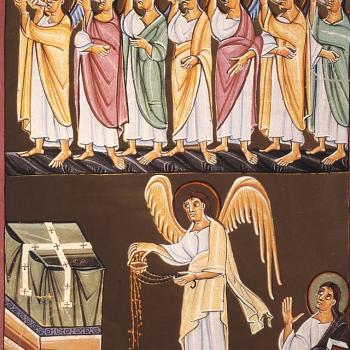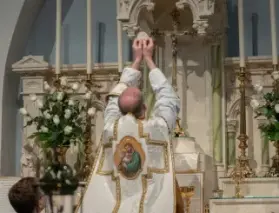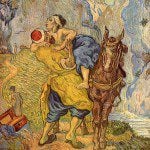Lectionary Reflections
Exodus 34:29-35
February 4, 2013
Today we end the season of Epiphany, that part of the church's year that celebrates the appearance of the one we call Lord, Jesus of Nazareth, born in a barn, recognized only by ignorant shepherds and great foreign magicians, destined to be ruler of the kings of the Earth who neither knew him nor cared anything for him. Yet, we say, he shines in the darkness, and with the Gospel of John, we affirm "the darkness has not overcome him."
The church has long found in this peculiar story of Moses and his shining face a prefiguring of the light forever to be seen in the face of Jesus. In the context of the book of Exodus, the tiny tale concludes the astonishing confrontation between Moses and YHWH on the sacred mountain of Sinai. Moses and his God have conversed long and hard on the mountain. YHWH has determined that the calf-builders at the base of the mountain deserve death, and so has demanded that Moses get out of the way of the divine wrath, after which Moses himself will be the foundation of a great nation, just like YHWH had promised Abraham so many years before (Ex. 32:7-10). But instead of responding to God's anger with submission and obedience, Moses instead argues God out of the intended destruction of the people (Ex. 32:11-14)!
But when Moses himself is confronted by the idolatry of the calf, he shatters the God-written tablets he has carried down from the mountain, destroys the offending calf, and instigates a great slaughter among those who perpetrated the deed (Ex. 32:15-20, 25-29). He asks Aaron, the calf-builder himself, to explain his terrible actions, but in response Aaron offers only the pitiable lie that he simply tossed the gold he requested from the Israelites into a nearby fire and, presumably miraculously, this calf popped out (Ex. 32:21-24)! But instead of punishing Aaron and the people, Moses goes back up the mountain to ask for YHWH's forgiveness. In fact, Moses says that if YHWH will not forgive the people, he demands that YHWH blot him, Moses, out of God's great book instead of the people (Ex. 32:32). Moses refuses to live in a world where YHWH does not forgive even the greatest of evil.
But then Moses demands more than YHWH is willing to give; Moses asks to see God's "glory" (Ex. 33:18), apparently God's very essence. YHWH refuses that bold request, but does reveal to Moses something very basic about the identity of the true God. This revelation echoes again and again throughout Israelite history and literature.
YHWH, YHWH, a God merciful and gracious,
Slow to anger, rich in unbreakable love and faithfulness,
Keeping unbreakable love for thousands of generations,
Forgiving iniquity, transgression, and sin... (Ex. 34:6-7)
With that revelation, Moses becomes the great lawgiver and intermediary of Israel, the figure to whom generations of believers have turned when they have sought a model of how to find relationship with their God, for "YHWH used to speak to Moses face to face, as one speaks to a friend" (Ex. 33:11). Hence, Moses is quite unique as a genuine friend of God, and all believers since have striven to find that same wonderful relationship with God.
But Exodus 34:29-35 illustrates that Moses remains as one set apart uniquely to serve as special guide for those who would know YHWH. This is so, because when "Moses came down from the mountain with the two tablets of the testimony (or perhaps "treaty" or "covenant") in his hand, he did not know that the skin of his face shone because he had been talking to God" (Ex. 34:29). The word translated "shone" here has a most interesting history. The Hebrew word is qeren, a word often meaning "horn." And so when Jerome translated the Hebrew Bible into Latin in the 4th century C.E., he employed the Latin word for "horn." Jerome's Vulgate version of the Scripture was the only version approved for use in the Roman church for many centuries, well up into the 20th century, in fact. Thus, the Vulgate was the Bible that the great Italian sculptor, Michelangelo, heard, which lead him to create his wonderful statue of Moses, festooned with horns on his head. Though this great work of the master's art was thus created from a translation error, it could be said that it is far easier to sculpt horns than shining in any case!
Thus, Moses came off Sinai with a brightly shining face, a condition that caused "Aaron and all Israel to fear to come near him" (Ex. 34:30). Still, Moses urged all of them to come close to him in order that he might speak to them. This was very important, since Moses had such crucial information to impart, namely "all that YHWH had spoken to him on Mount Sinai" (Ex. 34:32). Then we are told that after "Moses had finished speaking to them, he put a veil over his face" (Ex. 34:33). But whenever he would go in (to the moveable tabernacle presumably) to talk to YHWH, he would remove the veil (Ex. 34:34). But then after finishing his conversation with YHWH, after which his face would once again be radiant and shining, he would replace the veil in order to protect the people from the divine radiance that might impede their hearing and instituting the commands that Moses would tell them from their God.





